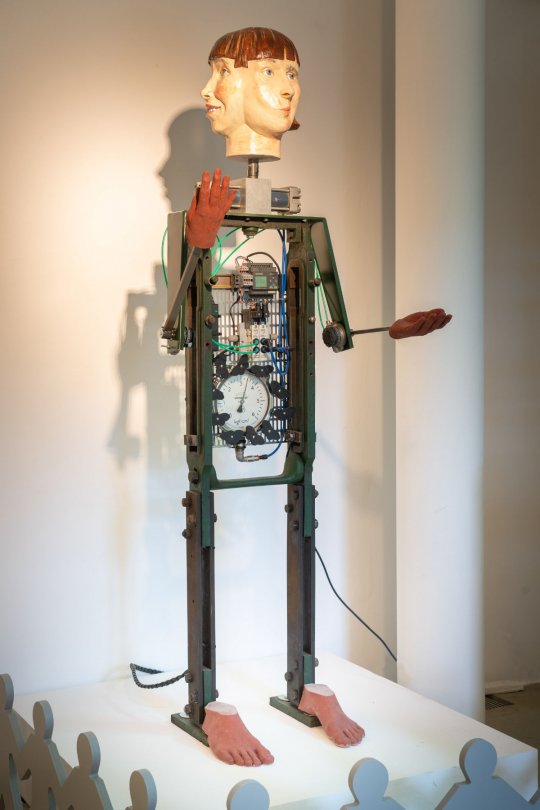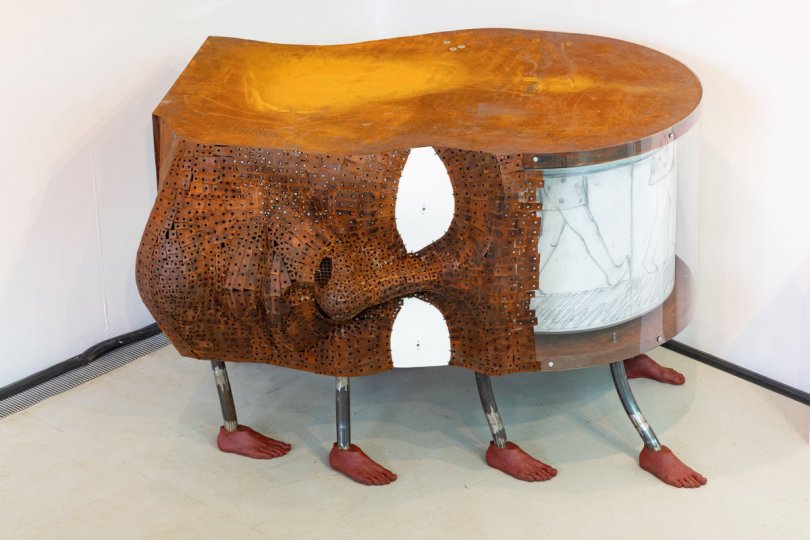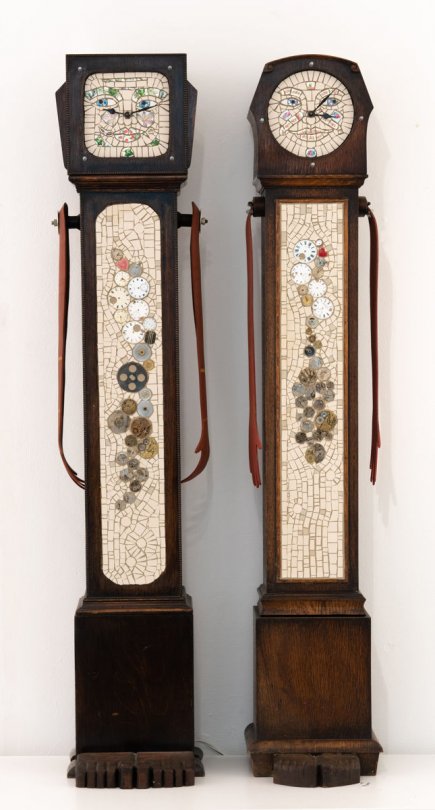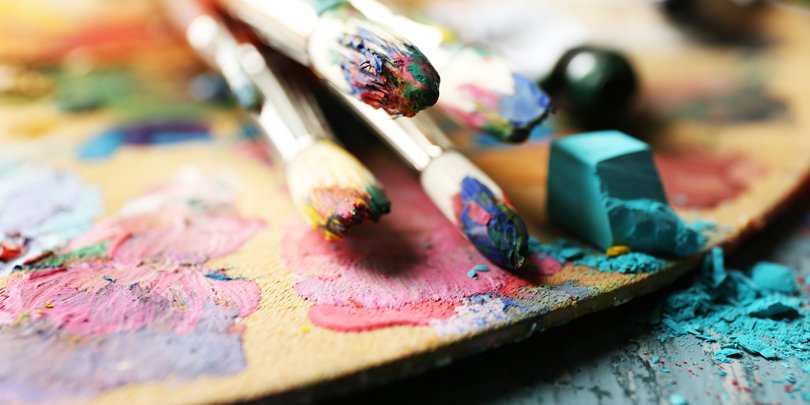Amanda Wray is an artist, art psychotherapist and BAAT Region 9 Co-ordinator
photos by Chris Webb, www.chriswebbphotography.com
While I was completing an MA in Art Therapy at the University of Derby in 2018, I was also in the process of applying for an Arts Council grant. At the time it was important for me to consider my next steps with art as well as the exciting prospect of qualifying as an art psychotherapist. I had ideas for new artworks and felt confident in the role of sculptor (I’ve been a practicing, exhibiting and self-employed artist since gaining a degree in sculpture in 1990), but less confident as a newly qualifying art therapist. I was keen to combine these two sides of myself.
I was looking for funding to make and tour a whole new body of work in collaboration with kinetic sculptor Johnny White. We have collaborated on many projects in the past and our styles work well together. We both enjoy the techniques of making things - I cast, carve, make mosaics and stop-motion animations, and Johnny has innovative engineering, electro-mechanical and metal working skills. Touring exhibition officer Janine Parish (from 20-21 Arts Centre in North Lincolnshire) was also on board to organise the tour venues and practicalities of touring the show. We secured £4,000 combined match funding from the Facey Foundation and Deershed Festival, along with a similar amount from North Lincolnshire Council. This was instrumental in us being awarded a substantial Arts Council England grant which covered our time and materials to make all the new work as well as promotional photographs, brochures and films, and family workshops at each venue.
At the time I was completing work for my MA and in the process of writing an essay about the potential usefulness of humour within art therapy, so my gratitude goes to Johnny and Janine for completing the lion’s share of the arts council application. In my essay I had discussed how humour can encourage a trusting therapeutic relationship, and also that it might offer a way to think about more difficult feelings, or a way out when things get too tricky, too fast. I wanted to make use of humour in a similar way within the exhibition. The sculptures with their clunky and amusing movements of eyes in a head, a carved baby being awkwardly birthed, a stroppy child noisily stomping her feet, and a death character wiggling a scythe, all have the intention of amusing onlookers whilst also touching on personal meanings with viewers. The overall theme of the exhibition Human Machines is inspired by everyday experiences and feelings, as well as pivotal moments in life, and we aimed to show that underneath it all we have more in common than we often think. This subject matter allowed me scope to include thoughts from my recent learning, as well as to play with and develop ideas within the collaboration.

Mid Life Crisis Bagatelle
wood (bought and found, worked by hand and machine), acrylic and found objects
The first piece we made is called Mid-Life Crisis Bagatelle which visitors are invited to play, and where jettisoned balls fall down holes with stereotypical labels such as ‘learn to play guitar’ or ‘climb a mountain’. The idea was to encourage people to play and interact with the sculpture, then it would (hopefully) make people smile (‘shave your body’ seemed to get a few laughs), and we hoped this would lead to people discussing what they had done themselves and why. Having hovered in the galleries listening to folk, we found this did happen and was often because (as the writing on the wall-based head and brain triptych above the game suggests) it was an opportune ‘Time for a change?’.

The Gaze
cast resin, woks, wood, TVs, steel, electro-mechanical components and found objects
The Gaze, for which I modelled a 2-metre-high head in clay, was cast twice in resin. Both heads have eyes which wander about the room before they rest gazing at each other. This activates the lighting of neurons in the back of each head, showing that the relationship between the two characters creates new neural pathways. Much of my recent learning about the importance of attachment, eye contact, attention, acknowledgement, reflection, and relationships are present in this piece. One head also contains an animation showing different feelings about meeting the gaze of another.

In Two Minds
upcycled tape-making machine, resin bonded plaster, cast rubber, pneumatics and electronics
Johnny and I found that, though we started with common ideas, we often recognised our own individual meanings in the artworks. This reminded me of the importance of allowing art therapy clients the space to explore the meaning of their creations and to also keep it in mind that what symbolises one thing to one person may symbolise something quite different to another. For example, the sculpture In Two Minds literally depicts the idiom of having butterflies in your stomach with simple black butterflies. I later discovered that black butterflies symbolise death in one culture and positive change in another. This sculpture moves her hands up and down alternately, as if she is weighing up the situation as her thoughts change (and this is shown by her head turning to show a different expression). I wanted to show someone trying to decide between what she feels she should do and what she wants to do, as in Winnicott’s well known description of true and false self (Winnicott, 1971). It is important to me that my artwork is accessible, and the push-the-button-to-activate nature of this show has made it very popular. To further encourage family and child visitors Janine designed some wonderful educational interactives to accompany the artwork (such as match-the-word-or-feeling-to-a-colour), and a reading area where children and adults can further explore ideas about feelings and emotions.

Hypnic Jerk
corten steel, steel, acrylic, cast rubber and drawings
At the time of writing this text, the current venue for Human Machines (Gracefield Arts Centre at Dumfries) is closed, due to the Covid-19 lockdown. This seems a small price to pay when so many people are suffering in cramped housing, struggling with their health or that of a loved one and helping to support and care for others. I’m pleased the show has already been exhibited at 4 venues and there are another 3 planned (and hopefully more will be secured after these). Sadly, my work as a therapist is also paused due to the Covid-19 lockdown. However, I’m taking the opportunity to get in my studio and make new sculptures. I hope other art therapists who are unable to meet with service users, face-to-face or online, are able to make use of time during social-distancing or self-isolating in this way too. I’ve noticed many art therapists find it difficult to make time for their own artwork and I’d like to encourage other art therapists to consider their art-making as having importance, and that it can be worthy of exhibiting and public funding. Their art doesn’t necessarily need to be justified as CPD or self-care, even though it can be both. I think that as art therapists it is important to acknowledge just how essential it is for us, and not just for our clients, to be creative. So perhaps during this unique and strange time of lockdown we can find some positives and encourage each other to make art.

Old Timers
recycled grandmother clocks, mosaic, Meccano, old crockery, old watch parts, rubber, carved wood, electronics
Human Machines will (hopefully) be open for exhibition at
Gracefield Arts Centre, Dumfries from soon - 5th September 2020
Cartwright Hall, Bradford from 28th November 2020 – 17th April 2021
The Dorman Museum, Middlesbrough 2nd May 2021 – 4th July 2021
Three small films about both the making of the artworks and the exhibition can be seen by following the below links:
https://youtu.be/Ikal-R8zmGs
https://youtu.be/Y8fi9ImugGs
https://youtu.be/pEUlS_8230U
References
Winnicott, D. W. (1971). Playing and reality. Psychology Press.
Images
Mid Life Bagatelle Wood (bought and found, worked by hand and machine), acrylic and found objects
The Gaze Cast resin, woks, wood, TVs, steel, electro-mechanical components and found objects
Hypnic Jerk Corten steel, steel, acrylic, cast rubber and drawings
In Two Minds Upcycled tape-making machine, resin bonded plaster, cast rubber, pneumatics and electronics
Old Timers Recycled grandmother clocks, mosaic, Meccano, old crockery, old watch parts, rubber, carved wood, electronics
Copyright (c) The British Association of Art Therapists (BAAT)
This article is published in BAAT Newsbriefing Summer 2020 and may not be distributed or published without the consent of BAAT

